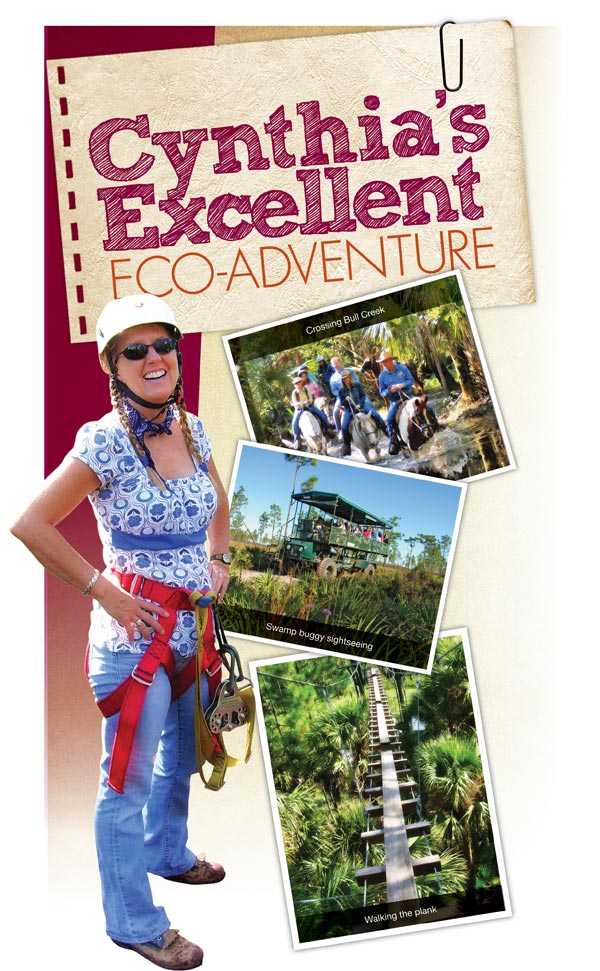
In the mood for a walk on Central Florida’s wild side? In this first-hand account of her trip to Forever Florida, a nature conservancy and working cattle ranch in the shadow of Walt Disney World, Ocala Style contributor Cynthia McFarland describes what it’s like to zip, swamp-buggy, and horseback ride across the 4,700-acre eco-ranch. Space Mountain has nothing on this place.
Don’t look down,” I whisper under my breath. “Just put one foot in front of the other.”
It’s not so much the height that makes me keep a firm grip on the handrails as the fact that I can see right through the metal steps to the ground far beneath my feet.
“You’re almost there!” calls Jody, one of two guides on this outing, as I start up the last flight of steps.
Moments later, I join him atop the 55-foot tower. As soon as I reach the top level, Jody snaps a cable to the harness I wear cinched snugly—if not attractively—about my lower torso. This is an immediate comfort. No matter what happens next, there’s no way I can fall. I like this small but important detail. I like it very much.
A panorama of wild Central Florida woods and wetlands surrounds us, and from our perch well above the trees, I see no signs of civilization. While the remaining members of our group climb the winding platform stairs to complete our little clan of adventurers, I scan the forest, looking for wildlife.
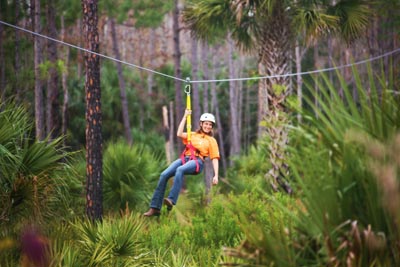
A zipline adventurer enjoys the view.
Cruising on a rising current, a red-shouldered hawk circles and cries, then coasts to a landing on a nearby branch. We’ve already spotted a group of deer grazing peacefully, but from here I see no sign of the wild hogs or gators that I know inhabit the sprawling land around us.
With our group of seven present and accounted for at the top of the tower, it’s time to get down to business, the fun business of “zipping,” that is.
Florida EcoSafaris at Forever Florida, a 4,700-acre nature conservancy and working cattle ranch in St. Cloud, offers guests the state’s first full zip-line course. I’ve never tackled a zip-line before, but if I can make it up those steps, skimming over the treetops from a steel cable should be a piece of cake.
Before we set out on our zip-line safari, guide Jaime helped us don harnesses and helmets, making sure all fit correctly. He and Jody then led us on a short, easy hike down a narrow path to the first tower. Zip-lines are typically built in areas where hills and mountains provide a natural rise to the land, but we are in Florida after all. A little man-made assistance is necessary to gain the elevation needed to “zip,” hence the tower platforms.
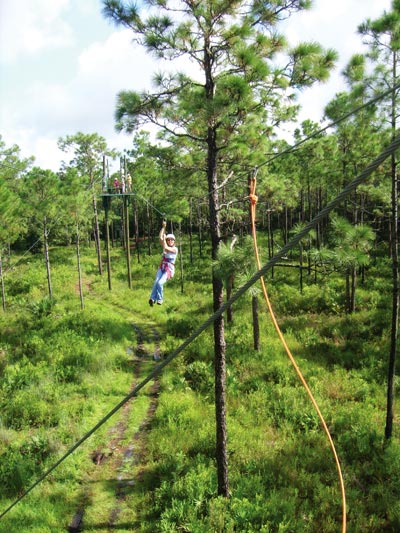
The writer takes the plunge.
Gail Czaban is the first of our group to launch. She and her twin sister, Marie Warburton, both of Trenton, Florida, discovered Florida EcoSafaris online. Jaime unhooks the snap that has tethered her to the platform and clips it onto the zip-line cable that stretches to the next tower where Jody has already zipped ahead and is waiting.
“Ready?” Jaime asks.
Gail nods and literally walks off the edge of the platform. A moment later she’s zipping along the cable, grinning from ear to ear.
My turn. Jaime tells me where to stand for “launching,” double-checks the gear, and gives me the go-ahead. I step off the tower and suddenly I’m whizzing above the trees. It’s impossible not to give a hearty “Yee haw!”
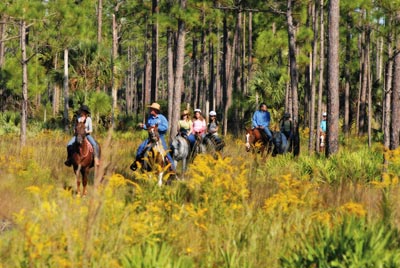
Horseback riding at Florida Forever.
Landing can be tricky, I quickly discover. I’m supposed to grab the rope dangling from the next platform to help guide me in, but in my excitement I forget and thud none too gracefully into Jody, who doesn’t complain and helps me regain my feet. He unsnaps the line that attached me to the zip-line and once again clips my harness securely to a cable on the tower. Moments later, another member of our group comes zipping in.
Over the next two hours, our group completes seven different zip-lines, the longest being 750 feet. Up here, weight means speed, so the heaviest adventurers actually zip along the fastest. Top speed is about 25 to 30 miles per hour. By holding the snap (never the cable!) correctly, riders can even control their bodies and avoid spinning helplessly like a sack of potatoes as they zip.
At one point, Jody tells us we must each make an animal noise as we zip to the next tower. If we don’t, he warns us with a grin, we’ll be left dangling in the middle. A hilarious assortment of pseudo animal voices punctuates this section of the zip-line, but I think laughter was the loudest sound of all.
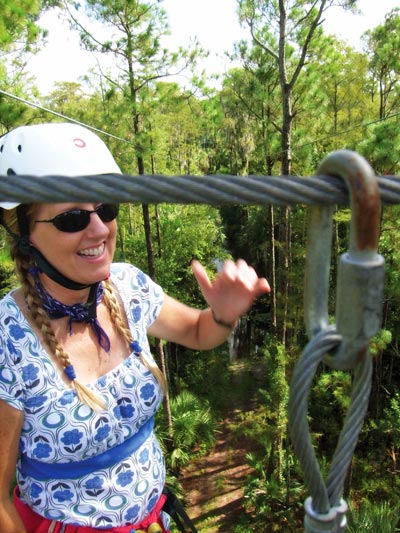
Cynthia celebrates after a zip.
There are two sections along the zip-line where “sky bridges” connect the towers. Picture the sort of narrow swinging rope bridge with wooden slats for steps that you see in wilderness action movies and you’ll get the idea. Of course, at all times, your harness is securely attached to the cable running along the top of the bridge. My head knows I can’t plunge to the earth below, but my feet don’t seem to grasp that concept as I make my wobbly way across the span.
It’s easy to see why the zip-line, which opened in January 2009, has become a huge hit with Florida locals as well as visitors from across the country and overseas. I’m sorry to reach the last tower. It’s been such a thrill that I want to do it again. I’m especially tempted by the starlight and moonlight zips on Saturday nights.
“Almost every time we’ve done it,” says Jody, “I’ve seen a shooting star.”
Our driver, Bob, is waiting for us at the end. On our way to the “coach,” an open-air, modified swamp buggy/bus on giant tires, we walk through the wildlife area. A small pond is home to the requisite alligators, albeit baby-sized, but there are also two adorable coatimundis—the South American version of our raccoon—red rat snakes, and a colorful parrot. Most impressive is Jasmine, a Florida panther hybrid bred specifically for education purposes.
“It’s estimated that there are only 70 Florida panthers left in the wild,” notes Matt Duda, director of sales and marketing. “It’s so important that their territory is being protected at Forever Florida. Seeing her in person really drives that home with our guests.”
The coach takes us along winding dirt roads and Bob keeps up an entertaining and informative narrative about the ranch as well as native plants and animals, even stopping on two occasions to point out and identify animal tracks in the mud. It’s easy to see why the guided coach eco safaris are so popular.
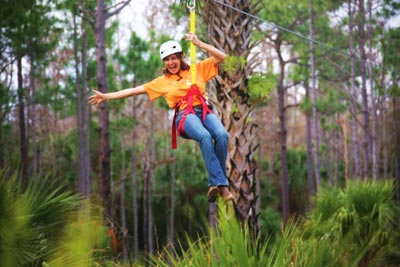
At the visitor center, a small gift shop offers a chance to browse, and the restaurant has several choices for sandwiches, salads, and snacks. After lunch, those of us who signed on for the horseback safari are met in the visitor center by Florida cowboy Alan. We follow him to the barn where we’re introduced to the reliable trail horses that will take us through the woods, scrub oak, and prairie. Amazingly, nine distinct ecosystems are preserved in their natural state on this eco-ranch.
I’m riding Meyers, a gray Florida Cracker gelding. Cracker horses are descendants of the horses originally brought to the New World by the Spanish explorers in the early-1500s. Hardy and sure-footed, Florida Cracker horses became the mount of choice for Florida cowboys. The riders often used whips to drive cattle out of thick brush, and the popping sound gave birth to the term “Florida Crackers.”
Since the Crescent J Ranch is a genuine cattle ranch, visitors can reserve a spot to help work cattle on horseback. We didn’t have much time, though, so we opted for a one-hour ride. The trail took us through hardwoods and hammock. At one point we rode past a flock of enormous wild turkeys less than two dozen feet away. The wildlife here seem to know they are protected, and it’s a treat to see them up close and unafraid.
Bull Creek is running high and our trail leads directly through the headwaters. Meyers isn’t a tall horse, so I hike my legs up on his shoulders to keep my boots out of the gently flowing water that comes within inches of the saddle seat. The afternoon is warm and the horses certainly seem to appreciate the cool water.
Back at the ranch, it’s time to say goodbye and return to Ocala, but I find myself reluctant to leave. The pervasive tranquility encompassing this place makes it hard to believe the frenetic activity of Orlando’s concrete-jungle attractions is barely an hour away.
“Our mission is to preserve wild Florida, to conserve and preserve Florida heritage and history,” says Matt. “Nature is something you can have fun with, but it also does good things for the soul. We get a lot of people, even locals, who can’t believe this is what their backyard is supposed to look like.”
Want To Learn More?
Florida EcoSafaris
4755 N. Kenansville Road, St. Cloud
(407) 957-9794
floridaecosafaris.com
Note: Advance reservations are required.






